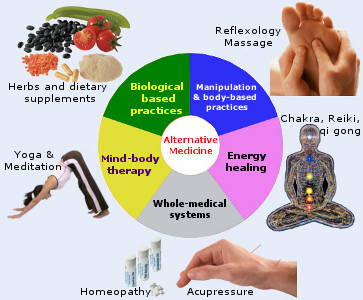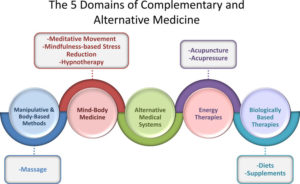
Table of Contents
What is Alternative Medicine?
- The term “Alternative Medicine” describes any form of practices that are used instead of western/modern medical treatments and doesn’t fall into conventional medical practice.
- Alternative Medicine includes more mainstream and accepted forms of medical modalities with many varieties.
- Alternative medicine is typically supported by tradition and seldom taught in a western medical setting
- Alternative medicine is stream of medicine that exists independently, beyond the domain of conventional medicine
- Therapies such as acupuncture, homeopathy and oriental practices are included in the alternative medicine and have been practiced for centuries worldwide
- These therapies are called ‘alternative’ as they may not always be effective or haven’t been proved to be 100% successful. As many of it are based on historical or cultural tradition, few of them also explores the folk knowledge.
- As alternative medicine has some of its foundation in the folk knowledge, the effectiveness of alternative medicines is always been discredited by modern medicine
- At present alternative medicine is also described as ‘complementary medicine’ by critics. Therefore, sometimes they are together known as ‘Complementary and Alternative Medicine’.
Types of Complementary and Alternative Medicine
1. Ayurveda
- It is an ancient therapy originated thousands of years ago in Vedic times in India
- Principles of Ayurveda are made up of 5 basic elements:
a) Akasa (ether)
b) Vayu (air)
c) Tejas (fire, minerals, acids, alkalis)
d) Jala (water)
e) Prithvi (organic substances & earthy matter)
- Combination of all these five elements classifies into 3 types of basic diagnoses:
– Vata (ether & air); responsible for movement in the body & mind
– Pittha (fire& water);functions associated with digestive processes, metabolic activity & body temperature
– Kapha (earth & water); corresponds to anabolism of body tissues & stored substances
- A person becomes ill due to the result of an imbalance in their doshas (vata, pittha and kapha) that must be rebalanced
- Ayurveda practice mainly focuses in maintaining the balance between all the aspects of life to promote health and well being
- Ayurveda has the potential to provide remedies to the many challenging health issues like drug withdrawals , adverse drug reactions and economic disparities without many side effects
- Examples: doing yoga, aroma therapy, massage therapy
2. Homeopathy
- Homeopathy is a popular treatment method from around 200 years from Germany
- Homeopathy focuses in two theories:
- law of similar and
- lower the dose the more effective the drug
- To many patients and some physicians, homeopathy was a mild, welcome alternative to bleeding, purging, polypharmacy, and other heavy-handed therapies of the day
- The homeopathic drug do not act as allopathic medicine but examines the patients symptoms and psychological condition.
- It has no/very less side effects and is thus well accepted by many persons.
3. Acupuncture
- Acupuncture is age old Chinese practice used to balance chi, the energy of life
- In Acupuncture, thin needles are placed at specific points in the body penetrating the skin which are then activated through gentle and specific movements of the practitioner’s hands or with electrical stimulation
- Acupuncture is primarily used to relieve pain but also has been used to treat other conditions
- Treatment applications are expansive and range from symptomatic treatment for depression, pain, gastrointestinal issues, allergic rhinitis
- Also, specific goal-oriented approaches such as with fertility treatments or decreasing the risk of chronic diseases such as cardiovascular disease are treated through Acupuncture.
4. Barefoot doctors
- Barefoot doctors originated back in China where the trained rural medical personnel were referred to as barefoot doctors
- When a mobile service team formed by urban medical workers began to provide medical services in rural areas, they trained some young peasants to function as ”barefoot doctors”
- Now these barefoot doctors are reaching almost every village, and currently are the backbone of the rural cooperative medical service
- The barefoot doctors are required to study both therapeutics and prophylaxis, both Western and traditional Chinese medicine
5. Naturopathy
- Naturopathy is the mixture of traditional and alternative approached to medicine that includes alternative, natural therapy to modern medicine
- It mainly focuses on the body capacity to heal by self by giving emphasis on diet, exercise, and stress management
- The principle and beliefs here are self-healing, harmless and holistic treatment with education and prevention
6. Other Forms of Alternative Medicine
- Various plants are used to treat disease and enhance general health and wellbeing which is known as herbal medicine. Herbal medicine products and supplements come in various forms including dried, minced, powdered or capsulated.
- Body manipulation is another type of alternative practice
- Yoga, massage, Tai chi, chiropractic, and Osteopathic manipulations all fall under it
- These are the ancient forms which have been proved to improve overall well-being of human
- Reiki, Biofeedback, Meditation, Hypnosis, Guided Imagery, etc. are other various forms of it

Importance/Advantages of Alternative Medicine
- Alternative medicine focuses on healing pain and disease by balancing out other aspects of your life
- It is a wide spectrum of therapies, and they are almost always considered to be much safer than mainstream medicine
- Alternative medicine is usually a natural or healthy approach. It uses natural substances like herbs, oils etc.
- Almost all mainstream medicine has some type of warning about the bad side effects that come from taking it; where as many of alternative medicines don’t/have very few side effects.
- Alternative medicine is relatively less expensive than the high tech and engineered medicines.
- Alternative medicine allows more flexibility in treatment plans where medical professional wont
- Alternative medicine doesn’t offer dependency treatment plans
- Boosts the immune system and works for overall health and wellbeing
These are the major reasons why alternative medicines are preferred by many people throughout the world.
Limitations/Barriers of Alternative Medicine
Although alternative medicine is widely accepted and preferred throughout the world, there are certain limitations and barriers to its use. Some of the major limitations and barriers of alternative medicine are:
- Relatively long term treatment plans and healing time
- Less useful in emergency situations where immediate and fast recovery is necessary
- Lack of adequate information among the people
- Much of alternative medicine isn’t approved by the U.S. Food and Drug Administration and other developed countries
- Limited scientific research on alternative medicines
- Researches related to alternative medicine have usually less sample size, poor controls and lack of comparison as compared to the modern medicines
- Usually, insurance does not cover the treatments done through alternative medicines
References and For More Information
https://www.ncbi.nlm.nih.gov/books/NBK538520/
https://pubmed.ncbi.nlm.nih.gov/10098319/
https://pubmed.ncbi.nlm.nih.gov/12408732/
https://www.medicalnewstoday.com/articles/alternative-medicine#mind-body-therapies
https://www.sanskritimagazine.com/healthy-living/different-types-alternative-medicine-practices/
https://www.britannica.com/science/homeopathy
https://www.hopkinsmedicine.org/health/wellness-and-prevention/acupuncture
https://southeasternspine.com/alternative-medicine-pros-and-cons/
https://www.ncbi.nlm.nih.gov/pmc/articles/PMC1119420/
https://onlinelibrary.wiley.com/doi/full/10.1002/tkm2.1225